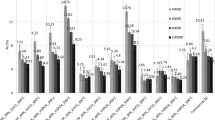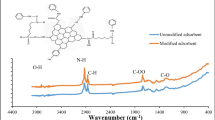Abstract
An experimental study was performed to determine the feasibility of using physically treated Candida tropicalis cells for sorption of Cu(II) and phenol, the role of competition between phenol molecules and Cu(II). The yeast cells were lyophilized (LC), heat-treated at 65 °C for 24 h (HT1), at 90 °C for 24 h (HT2), and 72 h (HT3), inactivated at 120 °C and 104 kPa for 20 min (PC). The adsorption isotherms were determined in batch system. Experimental equilibrium data were evaluated using Langmuir, Freundlich, and Dubinin–Radushkevich isotherm models by linear and non-linear regression. The adsorbed Cu(II) and phenol amounts by yeast cells were decreased due to the physical treatments of cells. With the increase of biomass dosage from 1 to 10 g L−1, the adsorption efficiency was increased. The Cu(II) adsorption capacity was also determined in the presence of phenol at various initial concentrations, and in these systems, phenol adsorption isotherms were determined. In the presence of phenol, the Cu(II) sorption capacity by lyophilized cells and carbon particles was decreased. The most commonly used sorbent in water treatment is activated carbon with large specific surface; therefore, the results were compared with the experimental data obtained by using activated carbon (AC).




Similar content being viewed by others
Abbreviations
- LC:
-
Lyophilized C. tropicalis cells
- PC:
-
C. tropicalis cells treated in pressure cook
- HT1:
-
C. tropicalis cells treated for 24 h, at 65 °C
- HT2:
-
C. tropicalis cells treated for 24 h, at 90 °C
- HT3:
-
C. tropicalis cells treated for 72 h, at 90 °C
- AC:
-
Activated carbon
References
Ahmad, M., Haydar, S., & Quraishi, T. (2013). Enhancement of biosorption of zinc ions from aqueous solution by immobilized Candida utilis and Candida tropicalis cells. International Biodeterioration & Biodegradation, 83, 119–128.
Alluri, H., Ronda, S., Settalluri, V., Singh, J., Bondili, S., & Venkateshwar, P. (2007). Biosorption: an eco-friendly alternative for heavy metal removal. African Journal of Biotechnology, 6, 2924–2931.
Brierley, C. (1990). Bioremediation of metal-contaminated surface and groundwaters. Geomicrobiology Journal, 8, 201–223.
Busca, G., Berardinelli, S., Resini, C., & Arrighi, L. (2008). Technologies for the removal of phenol from fluid streams: a short review of recent developments. Journal of Hazardous Materials, 160, 265–288.
Cervantes, C., & Gutierrezcorona, F. (1994). Copper resistance mechanisms in bacteria and fungi. FEMS Microbiology Reviews, 14, 121–137.
Chandran, P., & Das, N. (2011). Degradation of diesel oil by immobilized Candida tropicalis and biofilm formed on gravels. Biodegradation, 22, 1181–1189.
Chen, J., Chen, W., & Hsu, R. (1996). Biosorption of copper from aqueous solutions by plant root tissues. Journal of Fermentation and Bioengineering, 81, 458–463.
Dang, V., Doan, H., Dang-Vu, T., & Lohi, A. (2009). Equilibrium and kinetics of biosorption of cadmium(II) and copper(II) ions by wheat straw. Bioresource Technology, 100, 211–219.
Deng, P., Liu, W., Zeng, B., Qiu, Y., & Li, L. (2013). Sorption of heavy metals from aqueous solution by dehydrated powders of aquatic plants. International Journal of Environmental Science and Technology, 10, 559–566.
Edding, M., & Tala, F. (1996). Copper transfer and influence on a marine food chain. Bulletin of Environmental Contamination and Toxicology, 57, 617–624.
El-Sikaily, A., El Nemr, A., & Khaled, A. (2011). Copper sorption onto dried red alga Pterocladia capillacea and its activated carbon. Chemical Engineering Journal, 168, 707–714.
Fagundes-Klen, M., Veit, M., Borba, C., Bergamasco, R., Vaz, L., & da Silva, E. (2010). Copper biosorption by biomass of marine alga: study of equilibrium and kinetics in batch system and adsorption/desorption cycles in fixed bed column. Water, Air, and Soil Pollution, 213, 15–26.
Farkas, V., Felinger, A., Hegedusova, A., Dekany, I., & Pernyeszi, T. (2013). Comparative study of the kinetics and equilibrium of phenol biosorption on immobilized white-rot fungus Phanerochaete chrysosporium from aqueous solution. Colloids and Surfaces B, Biointerfaces, 103, 381–390.
Febrianto, J., Kosasih, A., Sunarso, J., Ju, Y., Indraswati, N., & Ismadji, S. (2009). Equilibrium and kinetic studies in adsorption of heavy metals using biosorbent: a summary of recent studies. Journal of Hazardous Materials, 162, 616–645.
Foo, K., & Hameed, B. (2010). Insights into the modeling of adsorption isotherm systems. Chemical Engineering Journal, 156, 2–10.
Hansen, H., Arancibia, F., & Gutierrez, C. (2010). Adsorption of copper onto agriculture waste materials. Journal of Hazardous Materials, 180, 442–448.
Harrison, F., & Katti, S. (1990). Hazards of linearization of Langmuir’s model. Chemometrics and Intelligent Laboratory Systems, 9, 249–255.
Jia, X., Wen, J., Ji, T., & Jiang, Y. (2011). Modelling of phenol biodegradation by Candida tropicalis immobilised in alginate gel beads. Canadian Journal of Chemical Engineering, 89, 1566–1574.
Jiang, Y., Wen, J., Li, H., Yang, S., & Hu, Z. (2005). The biodegradation of phenol at high initial concentration by the yeast Candida tropicalis. Biochemical Engineering Journal, 24, 243–247.
Jiang, Y., Wen, J., Lan, L., & Hu, Z. (2007). Biodegradation of phenol and 4-chlorophenol by the yeast Candida tropicalis. Biodegradation, 18, 719–729.
Jiang, Y., Cai, X., Wu, D., & Ren, N. (2010). Biodegradation of phenol and m-cresol by mutated Candida tropicalis. Journal of Environmental Sciences-China, 22, 621–626.
Junghans, K., & Straube, G. (1991). Biosorption of copper by yeasts. Biology of Metals, 4, 233–237.
Kim, B., Gee, C., Bandy, J., Huang, C., & Guzewich, D. (1990). Hazardous wastes treatment technologies. Research Journal of the Water Pollution Control Federation, 62, 511–519.
Koyuncu, H., Yildiz, N., Salgin, U., Koroglu, F., & Calimli, A. (2011). Adsorption of o-, m- and p-nitrophenols onto organically modified bentonites. Journal of Hazardous Materials, 185, 1332–1339.
Mantovi, P., Bonazzi, G., Maestri, E., & Marmiroli, N. (2003). Accumulation of copper and zinc from liquid manure in agricultural soils and crop plants. Plant and Soil, 250, 249–257.
Miranda, C., & Rojas, R. (2006). Copper accumulation by bacteria and transfer to scallop larvae. Marine Pollution Bulletin, 52, 293–300.
Nica, D., Bura, M., Gergen, I., Harmanescu, M., & Bordean, D. (2012). Bioaccumulative and conchological assessment of heavy metal transfer in a soil-plant-snail food chain. Chemistry Central Journal, 6.
Olexsey, R. (1986). Treatment technologies for hazardous wastes. Journal of the Air Pollution Control Association, 36, 66.
Pamukoglu, M., & Kargi, F. (2009). Removal of Cu(II) ions by biosorption onto powdered waste sludge (PWS) prior to biological treatment in an activated sludge unit: a statistical design approach. Bioresource Technology, 100, 2348–2354.
Rehman, A., & Anjum, M. S. (2010). Cadmium uptake by yeast, Candida tropicalis, isolated from industrial effluents and its potential use in wastewater clean-up operations. Water, Air, and Soil Pollution, 205, 149–159.
Rehman, A., & Anjum, M. (2011). Multiple metal tolerance and biosorption of cadmium by Candida tropicalis isolated from industrial effluents: glutathione as detoxifying agent. Environmental Monitoring and Assessment, 174, 585–595.
Rehman, A., Farooq, H., & Shakoori, A. (2007). Copper tolerant yeast, Candida tropicalis, isolated from industrial effluents: its potential use in wastewater treatment. Pakistan Journal of Zoology, 39, 405–412.
Rehman, A., Anjum, M., & Hasnain, S. (2010). Cadmium biosorption by yeast, Candida tropicalis CBL-1, isolated from industrial wastewater. Journal of General and Applied Microbiology, 56, 359–368.
Tsekova, K., Ganeva, S., Hristov, A., Todorova, D., & Beschkov, V. (2011). Simultaneous copper, cobalt and phenol removal from aqueous solutions by alternating biosorption and biodegradation. Water Science and Technology, 63, 2388–2394.
Varma, R., & Gaikwad, B. (2008). Rapid and high biodegradation of phenols catalyzed by Candida tropicalis NCIM 3556 cells. Enzyme and Microbial Technology, 43, 431–435.
Varma, R., & Gaikwad, B. (2009). Biodegradation and phenol tolerance by recycled cells of Candida tropicalis NCIM 3556. International Biodeterioration & Biodegradation, 63, 539–542.
Veglio, F., & Beolchini, F. (1997). Removal of metals by biosorption: a review. Hydrometallurgy, 44, 301–316.
Veneu, D., Torem, M., & Pino, G. (2013). Fundamental aspects of copper and zinc removal from aqueous solutions using a Streptomyces lunalinharesii strain. Minerals Engineering, 48, 44–50.
Vijayaraghavan, K., Padmesh, T., Palanivelu, K., & Velan, M. (2006). Biosorption of nickel(II) ions onto Sargassum wightii: application of two-parameter and three-parameter isotherm models. Journal of Hazardous Materials, 133, 304–308.
Volesky, B., & Holan, Z. (1995). Biosorption of heavy-metals. Biotechnology Progress, 11, 235–250.
Acknowledgments
Tímea Pernyeszi, Krisztina Honfi, and Ferenc Kilár gratefully acknowledge the support for this research from TAMOP-4.2.2.A11/1/KONV-2012-0065 and OTKA 10067 (Hungarian research grants).
Author information
Authors and Affiliations
Corresponding author
Additional information
Highlights
• Cu(II) and phenol biosorption equilibrium by treated Candida tropicalis cells
• Single and binary biosorption systems
• Competitive biosorption study
• Equilibrium evaluation by isotherm equations using linear and non-linear regression
Rights and permissions
About this article
Cite this article
Honfi, K., Tálos, K., Kőnig-Péter, A. et al. Copper(II) and Phenol Adsorption by Cell Surface Treated Candida tropicalis Cells in Aqueous Suspension. Water Air Soil Pollut 227, 61 (2016). https://doi.org/10.1007/s11270-016-2751-0
Received:
Accepted:
Published:
DOI: https://doi.org/10.1007/s11270-016-2751-0




